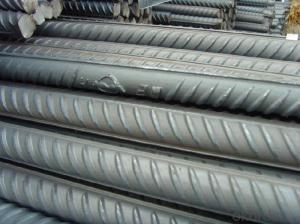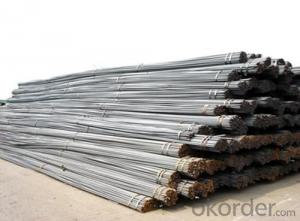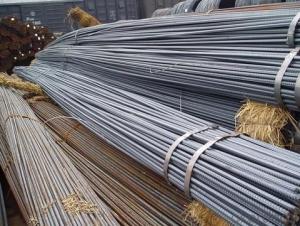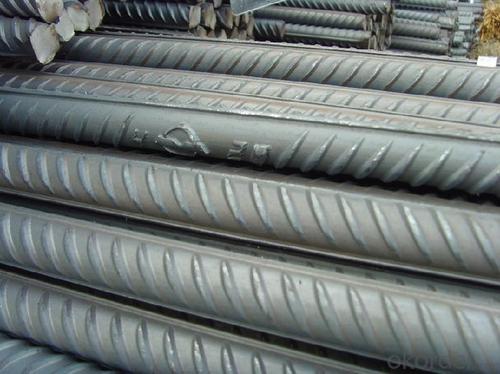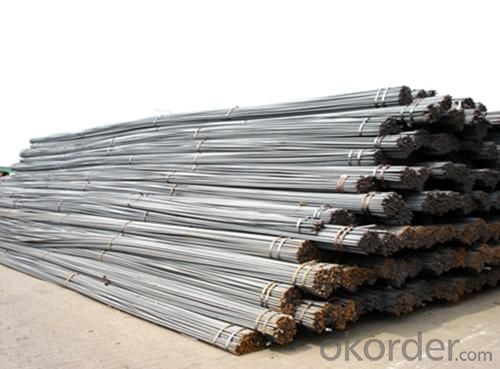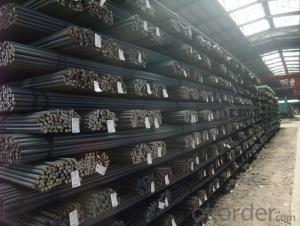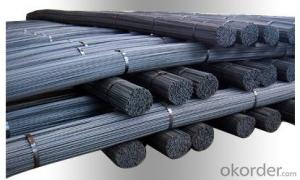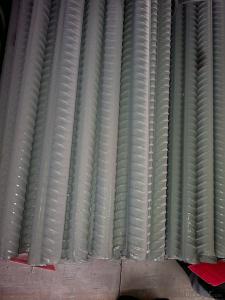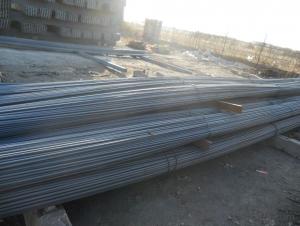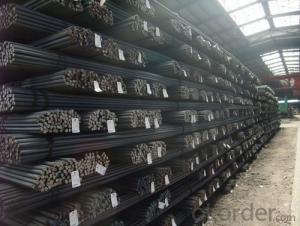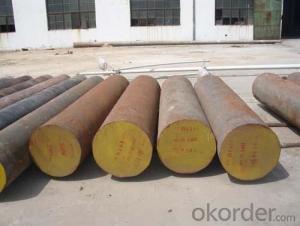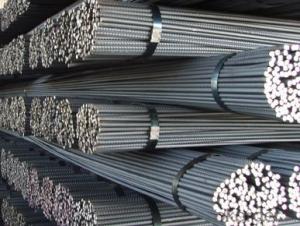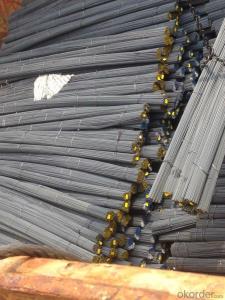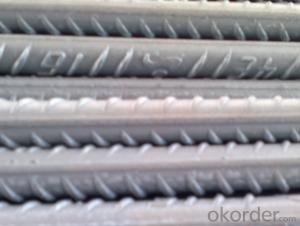Deformed Steel Bars All Size Steel Rebars Made In China
- Loading Port:
- Tianjin
- Payment Terms:
- TT or LC
- Min Order Qty:
- 25 m.t.
- Supply Capability:
- 24000 m.t./month
OKorder Service Pledge
OKorder Financial Service
You Might Also Like
Product Description:
OKorder is offering Deformed Steel Bars All Size Steel Rebars Made In China at great prices with worldwide shipping. Our supplier is a world-class manufacturer of steel, with our products utilized the world over. OKorder annually supplies products to European, North American and Asian markets. We provide quotations within 24 hours of receiving an inquiry and guarantee competitive prices.
Product Applications:
Deformed Steel Bars All Size Steel Rebars Made In China are ideal for structural applications and are widely used in the construction of buildings and bridges, and the manufacturing, petrochemical, and transportation industries.
Product Advantages:
OKorder's Deformed Steel Bars All Size Steel Rebars Made In China are durable, strong, and resist corrosion.
Main Product Features:
· Premium quality
· Prompt delivery & seaworthy packing (30 days after receiving deposit)
· Corrosion resistance
· Can be recycled and reused
· Mill test certification
· Professional Service
· Competitive pricing
Product Specifications:
1.commodity:deformed steel bars
2.grade:ASTM A615 HRB335 HRB400 HRB500 BS4449 grade460
3.size:6#-32#
4.length:6m 9m 12m
Chemistry % | |||||||||||||
Designation | Chief component | Impurities maxmium | |||||||||||
Ta | Nb | Fe | Si | Ni | W | Mo | Ti | Nb | O | C | H | N | |
Ta1 | Remainder | 0.004 | 0.003 | 0.002 | 0.004 | 0.004 | 0.002 | 0.03 | 0.015 | 0.004 | 0.0015 | 0.002 | |
Ta2 | Remainder | 0.01 | 0.01 | 0.005 | 0.02 | 0.02 | 0.005 | 0.08 | 0.02 | 0.01 | 0.0015 | 0.01 | |
Permissible variations in diameter for rods
Diameter, inch (mm) | Tolerance, +/-inch (mm) |
0.125~0.187 excl (3.175~4.750) | 0.003 (0.076) |
0.187~0.375 excl (4.750~9.525) | 0.004 (0.102) |
0.375~0.500 excl (9.525~12.70) | 0.005 (0.127) |
0.500~0.625 excl (12.70~15.88) | 0.007 (0.178) |
0.625~0.750 excl (15.88~19.05) | 0.008 (0.203) |
0.750~1.000 excl (19.05~25.40) | 0.010 (0.254) |
1.000~1.500 excl (25.40~38.10) | 0.015 (0.381) |
1.500~2.000 excl (38.10~50.80) | 0.020 (0.508) |
2.000~2.500 excl (50.80~63.50) | 0.030 (0.762) |
FAQ:
Q1: Why buy Materials & Equipment from OKorder.com?
A1: All products offered byOKorder.com are carefully selected from China's most reliable manufacturing enterprises. Through its ISO certifications, OKorder.com adheres to the highest standards and a commitment to supply chain safety and customer satisfaction.
Q2: How do we guarantee the quality of our products?
A2: We have established an advanced quality management system which conducts strict quality tests at every step, from raw materials to the final product. At the same time, we provide extensive follow-up service assurances as required.
Q3: How soon can we receive the product after purchase?
A3: Within three days of placing an order, we will begin production. The specific shipping date is dependent upon international and government factors, but is typically 7 to 10 workdays.
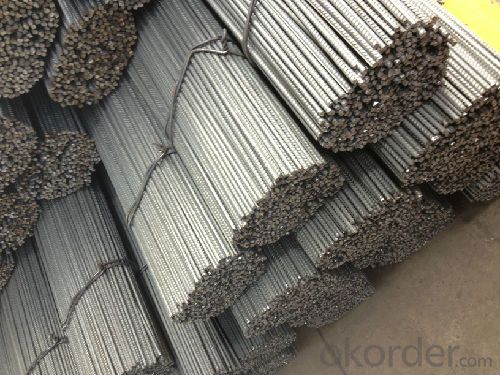
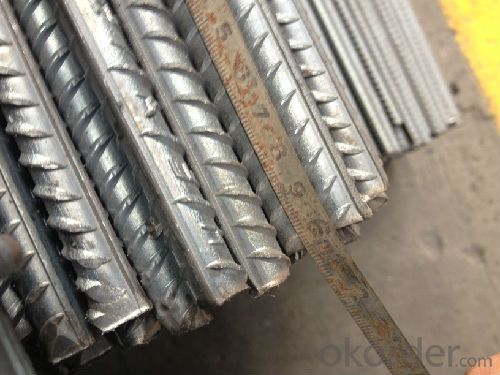

- Q: What are the guidelines for proper storage and transportation of steel rebars?
- The guidelines for proper storage and transportation of steel rebars include keeping them off the ground to avoid moisture and corrosion, storing them in a well-ventilated area, organizing them in a neat and stable manner to prevent falling or shifting, protecting them from direct exposure to weather conditions, and securing them properly during transportation to avoid damage or accidents.
- Q: How do steel rebars affect the overall weight of a construction project?
- Steel rebars can significantly impact the overall weight of a construction project. As reinforcing bars, or rebars, are typically made of steel, their inclusion in structures increases the weight of the project. By reinforcing concrete, rebars provide necessary strength and durability, enabling structures to withstand greater loads and forces. However, the added weight of steel rebars must be taken into account during the design and construction phases to ensure the overall stability and safety of the project.
- Q: What are the guidelines for proper handling and disposal of steel rebars on construction sites?
- The guidelines for proper handling and disposal of steel rebars on construction sites include wearing appropriate personal protective equipment (PPE) such as gloves and safety glasses, using proper lifting techniques to avoid injury, storing rebars in a designated area away from workers and equipment, and disposing of them in accordance with local regulations, which may require recycling or proper disposal in designated waste sites.
- Q: How do steel rebars affect the overall durability of marine structures?
- Enhancing the overall durability of marine structures, steel rebars play a vital role. The high tensile strength and corrosion resistance of these rebars ensure structural stability and prevent degradation caused by saltwater, waves, and harsh weather conditions. Corrosion is a major challenge faced by marine structures due to constant exposure to saltwater, weakening the structure over time. To combat this, steel rebars are often coated with anti-corrosive materials like epoxy or galvanized coatings. These coatings act as a protective layer, preventing the penetration of saltwater and other corrosive agents, ensuring the longevity of the marine structure. In addition to corrosion resistance, steel rebars are known for their high tensile strength, allowing them to withstand the tremendous forces of waves and currents. They reinforce the concrete used in marine structures, preventing cracks or failure under excessive loads. This reinforcement enhances the structural integrity of the marine structure, making it more resilient against external forces. Moreover, steel rebars offer flexibility in design and construction, allowing for the creation of complex and robust marine structures. Engineers can bend and shape the rebars as needed, designing structures that can better withstand the unique challenges of the marine environment. This flexibility also streamlines the construction process, making it more efficient and cost-effective. Overall, steel rebars make a significant contribution to the durability of marine structures by providing corrosion resistance, enhancing structural stability, and enabling innovative design solutions. Their presence ensures the longevity and reliability of marine structures, enabling them to withstand the harsh conditions of the marine environment for extended periods.
- Q: What are the guidelines for storing steel rebars on a construction site?
- The guidelines for storing steel rebars on a construction site typically include keeping them off the ground to prevent rust and corrosion, stacking them neatly and securely to avoid accidents, and protecting them from exposure to moisture and other harmful elements. It is also important to separate different sizes and types of rebars to ensure easy identification and accessibility when needed.
- Q: How do steel rebars affect the overall workability of concrete?
- Concrete's overall workability is significantly improved by steel rebars. Workability refers to how easily concrete can be mixed, placed, compacted, and finished to achieve the desired shape and surface. The incorporation of steel rebars into concrete provides reinforcement and enhances its structural strength. These rebars act as a skeleton within the concrete matrix and evenly distribute loads and stresses throughout the structure. This reinforcement prevents cracking, improves structural integrity, and increases the concrete's load-bearing capacity. Steel rebars also aid in controlling shrinkage and cracking in concrete. During the curing process, concrete tends to shrink, leading to crack formation. However, the presence of rebars counteracts the tensile forces causing shrinkage and cracking, thus enhancing the concrete's overall durability. In addition to their structural benefits, steel rebars also facilitate concrete workability during construction. They guide proper concrete placement and prevent mix segregation or separation. These rebars ensure proper compaction, eliminating potential voids or air pockets and resulting in a more uniform mixture. Furthermore, steel rebars provide stability and support to concrete during curing and hardening stages. They prevent deformation or sagging of fresh concrete, ensuring it maintains its desired shape and form. This is particularly crucial for complex or intricate structures requiring precise shaping and positioning. Overall, the inclusion of steel rebars positively impacts concrete workability by enhancing structural strength, mitigating shrinkage and cracking, facilitating proper placement and compaction, and providing stability during the curing process. The combination of concrete and steel rebars creates a durable and reliable construction material capable of withstanding various loads and environmental conditions.
- Q: How do steel rebars help in preventing cracks in concrete structures?
- Steel rebars help in preventing cracks in concrete structures by providing reinforcement and increasing the tensile strength of the concrete. Concrete is strong in compression but weak in tension, and when subjected to external forces or changes in temperature, it tends to crack. However, by embedding steel rebars within the concrete, the tensile forces are transferred to the rebars, preventing the concrete from cracking. The rebars act as a skeleton within the concrete, distributing the tension forces evenly and preventing the formation of large cracks. This reinforcement also helps to control the size and width of any cracks that do occur, minimizing their impact on the overall structural integrity. Moreover, steel rebars help in preventing cracks by improving the ductility of the concrete. Ductility refers to the ability of a material to deform without breaking. The steel rebars provide flexibility to the concrete, allowing it to undergo small deformations without cracking. In addition, steel rebars also help in preventing cracks by reducing the effects of shrinkage and expansion. Concrete tends to shrink as it dries and expands when exposed to high temperatures. These shrinkage and expansion forces can lead to cracking, but the presence of steel rebars helps to counteract these effects by absorbing and distributing the forces. Overall, steel rebars play a crucial role in preventing cracks in concrete structures by reinforcing the concrete, increasing its tensile strength, improving its ductility, and countering the effects of shrinkage and expansion. This reinforcement ensures the structural integrity and durability of the concrete, making it more resistant to cracking and enhancing its overall performance and longevity.
- Q: How do steel rebars prevent concrete structures from collapsing?
- Reinforcement and strength are provided to concrete structures by steel rebars, which prevent their collapse. Concrete is capable of withstanding forces that compress or squeeze it, making it a strong material. However, it is not able to withstand forces that pull it apart, resulting in weakness in tension. When subjected to tension, concrete may crack and ultimately fail. To counteract these tensile forces and offer additional strength, reinforcement bars, also known as steel rebars, are typically embedded within concrete structures. These rebars are made of high-strength steel and are strategically placed to resist the pulling forces. When external forces, such as wind or seismic activity, impact a concrete structure, the rebars assist in distributing the load and resisting tension. As the concrete attempts to separate, the rebars hold it together, preventing the propagation of cracks and maintaining the structure's integrity. Additionally, the rebars enhance the overall durability and lifespan of the concrete structure. By reinforcing the concrete, they mitigate the effects of shrinkage and thermal expansion, which can lead to cracks over time. Consequently, a more stable and resilient structure is achieved, capable of withstanding various environmental and structural stresses. In conclusion, steel rebars are crucial in averting the collapse of concrete structures, as they provide the necessary reinforcement and strength to resist tension. They elevate the structural integrity, durability, and safety of concrete structures, ensuring their ability to withstand demands and fulfill their intended purpose for extended periods.
- Q: Can steel rebars be replaced with other reinforcement materials?
- Yes, it is possible to replace steel rebars with other materials for reinforcement. Steel rebars have been widely used in construction due to their strength and durability, but there have been advancements in alternative materials that offer comparable or even enhanced properties. One such alternative is the use of fiber-reinforced polymer (FRP) bars. These bars are composed of high-strength fibers embedded in a polymer matrix. FRP bars possess qualities such as lightweightness, corrosion-resistance, and high tensile strength, making them an appealing substitute for steel rebars. Additionally, they are non-conductive and non-magnetic, which makes them suitable for applications in areas with electromagnetic interference or in industries that require sensitivity to electronics. Another alternative is carbon fiber reinforced polymer (CFRP) bars, which are similar to FRP bars but are specifically reinforced with carbon fibers. CFRP bars offer even greater tensile strength and stiffness compared to steel rebars, making them particularly well-suited for structures that necessitate exceptional load-bearing capabilities. Moreover, natural fiber reinforced composites (NFRC) have been explored as an alternative to steel rebars. NFRC can be created using materials such as bamboo, jute, or sisal fibers embedded in a matrix material like cement or polymer. These natural fibers provide good tensile strength and can be a sustainable and cost-effective substitute for steel rebars, especially in regions where these fibers are readily available. In conclusion, although steel rebars have traditionally been the go-to choice for reinforcement materials in construction, alternatives such as FRP bars, CFRP bars, and NFRC can serve as viable replacements. The selection of reinforcement material depends on various factors including structural requirements, environmental conditions, and cost-effectiveness.
- Q: What are the different corrosion protection methods for steel rebars?
- There are several corrosion protection methods for steel rebars, including epoxy coating, galvanization, concrete cover, and cathodic protection. Epoxy coating involves applying a layer of epoxy paint on the rebar surface to prevent direct contact with corrosive agents. Galvanization is the process of coating the rebar with a layer of zinc, which acts as a sacrificial anode and protects the steel from corrosion. Concrete cover refers to the thickness of concrete surrounding the rebar, acting as a physical barrier against corrosive elements. Cathodic protection involves the use of a sacrificial anode or an impressed current system to create an electric field that prevents the corrosion of steel rebars.
Send your message to us
Deformed Steel Bars All Size Steel Rebars Made In China
- Loading Port:
- Tianjin
- Payment Terms:
- TT or LC
- Min Order Qty:
- 25 m.t.
- Supply Capability:
- 24000 m.t./month
OKorder Service Pledge
OKorder Financial Service
Similar products
Hot products
Hot Searches
Related keywords
